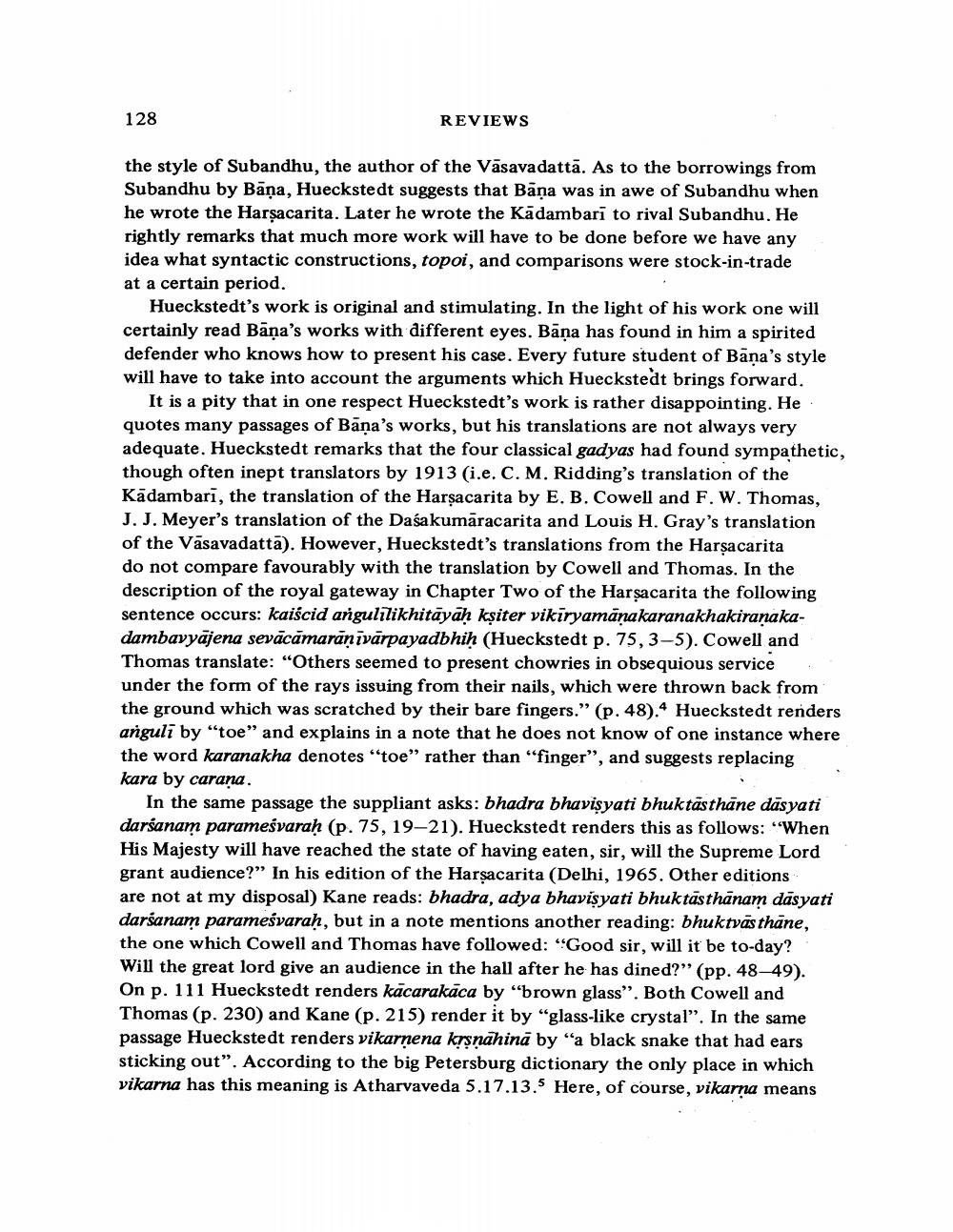________________
128
REVIEWS
the style of Subandhu, the author of the Vasavadattā. As to the borrowings from Subandhu by Bāņa, Hueckstedt suggests that Bāna was in awe of Subandhu when he wrote the Harşacarita. Later he wrote the Kādambari to rival Subandhu. He rightly remarks that much more work will have to be done before we have any idea what syntactic constructions, topoi, and comparisons were stock-in-trade at a certain period.
Hueckstedt's work is original and stimulating. In the light of his work one will certainly read Bana's works with different eyes. Bana has found in him a spirited defender who knows how to present his case. Every future student of Bana's style will have to take into account the arguments which Hueckstedt brings forward.
It is a pity that in one respect Hueckstedt's work is rather disappointing. He quotes many passages of Bana's works, but his translations are not always very adequate. Hueckstedt remarks that the four classical gadyas had found sympathetic, though often inept translators by 1913 i.e. C. M. Ridding's translation of the Kadambarī, the translation of the Harsacarita by E. B. Cowell and F. W. Thomas, J.J. Meyer's translation of the Dasakumaracarita and Louis H. Gray's translation of the Vasavadatta). However, Hueckstedt's translations from the Harsacarita do not compare favourably with the translation by Cowell and Thomas. In the description of the royal gateway in Chapter Two of the Harsacarita the following sentence occurs: kaiścid angulilikhitāyaḥ kṣiter vikīryamanakaranakhakiranakadambavyājena sevācamarānīvārpayadbhiḥ (Hueckstedt p. 75, 3-5). Cowell and Thomas translate: "Others seemed to present chowries in obsequious service under the form of the rays issuing from their nails, which were thrown back from the ground which was scratched by their bare fingers.” (p. 48).4 Hueckstedt renders anguli by “toe" and explains in a note that he does not know of one instance where the word karanakha denotes "toe” rather than "finger”, and suggests replacing kara by carana.
In the same passage the suppliant asks: bhadra bhavisyati bhuktāsthane dasyati darśanam parameśvaraḥ (p. 75, 19-21). Hueckstedt renders this as follows: "When His Majesty will have reached the state of having eaten, sir, will the Supreme Lord grant audience?” In his edition of the Harşacarita (Delhi, 1965. Other editions are not at my disposal) Kane reads: bhadra, adya bhavisyati bhuktāsthanam dasyati darśanam parameśvaraḥ, but in a note mentions another reading: bhuktvästhāne, the one which Cowell and Thomas have followed: "Good sir, will it be to-day? Will the great lord give an audience in the hall after he has dined?” (pp. 48-49). On p. 111 Hueckstedt renders kācarakāca by "brown glass”. Both Cowell and Thomas (p. 230) and Kane (p. 215) render it by "glass-like crystal". In the same passage Hueckstedt renders vikarnena krsnahina by "a black snake that had ears sticking out". According to the big Petersburg dictionary the only place in which vikarna has this meaning is Atharvaveda 5.17.13.5 Here, of course, vikarna means




